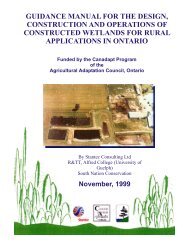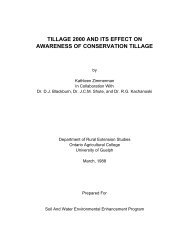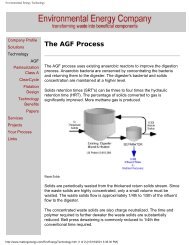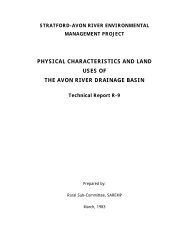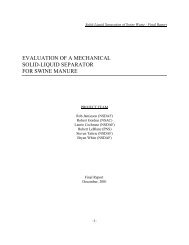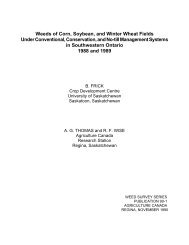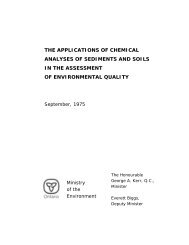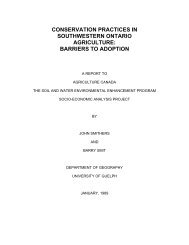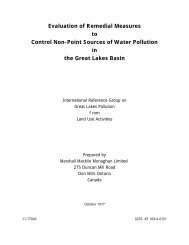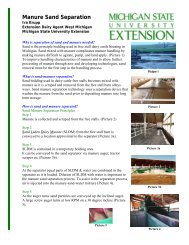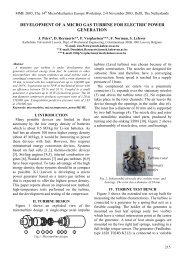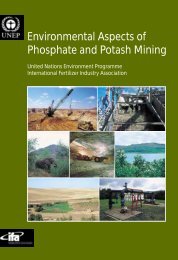Beyond Factory Farming: Corporate Hog Barns and the Threat to ...
Beyond Factory Farming: Corporate Hog Barns and the Threat to ...
Beyond Factory Farming: Corporate Hog Barns and the Threat to ...
Create successful ePaper yourself
Turn your PDF publications into a flip-book with our unique Google optimized e-Paper software.
<strong>Beyond</strong> <strong>Fac<strong>to</strong>ry</strong> <strong>Farming</strong><br />
In revisions <strong>to</strong> <strong>the</strong> Federal Clean Water Act originally promulgated<br />
in 1972, new rules concerning lives<strong>to</strong>ck operations were issued<br />
in December 2002. These rules specify <strong>the</strong> primary problem as<br />
coming from large lives<strong>to</strong>ck operations, in part because large operations<br />
are more likely than smaller operations <strong>to</strong> have an insufficient<br />
l<strong>and</strong> base for utilizing manure nutrients. In short, an imbalance has<br />
been created in which <strong>the</strong> nutrients required <strong>to</strong> grow hogs are taken<br />
from local farm environments <strong>and</strong> concentrated in small areas. As a<br />
result, solid manure that was once widely distributed fertilizer for<br />
large numbers of sustainable farm systems is transformed in<strong>to</strong> a liquid<br />
industrial waste product contaminating <strong>the</strong> water <strong>and</strong> air.<br />
A common environmental problem created by large concentrations<br />
of hogs <strong>and</strong> manure is <strong>the</strong> degradation of air quality. Some 160<br />
volatile organic compounds are emitted from liquid hog manure <strong>and</strong><br />
<strong>the</strong>ir odiferous character can offend even <strong>the</strong> most seasoned farmer<br />
or rural resident. Industrial production facilities housing thous<strong>and</strong>s<br />
of swine come with s<strong>to</strong>rage facilities holding hundreds of thous<strong>and</strong>s,<br />
even millions, of gallons of liquid manure. Large exhaust fans dot<br />
<strong>the</strong> exterior walls of <strong>the</strong>se facilities testifying <strong>to</strong> <strong>the</strong> fact that <strong>the</strong> interior<br />
ambient environment is not particularly healthy, so particulates<br />
<strong>and</strong> gases are forced outside. Indeed, fully a third of workers working<br />
inside <strong>the</strong>se facilities will develop one or more chronic respira<strong>to</strong>ry<br />
problem in direct response <strong>to</strong> exposure <strong>to</strong> gas <strong>and</strong> dust mixtures<br />
(Merchant et al., 2002). Compounds such as hydrogen sulfide <strong>and</strong><br />
ammonia, blended with dusts <strong>and</strong> endo<strong>to</strong>xin, also create problems<br />
for neighbours, particularly when large volumes of manure are s<strong>to</strong>red<br />
in liquid form. Anyone who has spent even a little time on farms<br />
clearly underst<strong>and</strong>s that some type of odour is inherent <strong>to</strong> <strong>the</strong> agricultural<br />
environment. However, concentrating hundreds of thous<strong>and</strong>s<br />
of gallons of liquid manure in one area is anything but natural<br />
<strong>and</strong> can have a devastating quality-of-life effect on neighbouring farmers<br />
<strong>and</strong> o<strong>the</strong>r rural residents.<br />
More than merely an unpleasant sensation, odour can have lifealtering<br />
consequences for denizens of rural communities who relish<br />
a way of life premised on enjoying <strong>the</strong> out-of-doors (Thu &<br />
Durrenberger, 1994; Flora et al., 2002). Neighbours of industrial<br />
17



